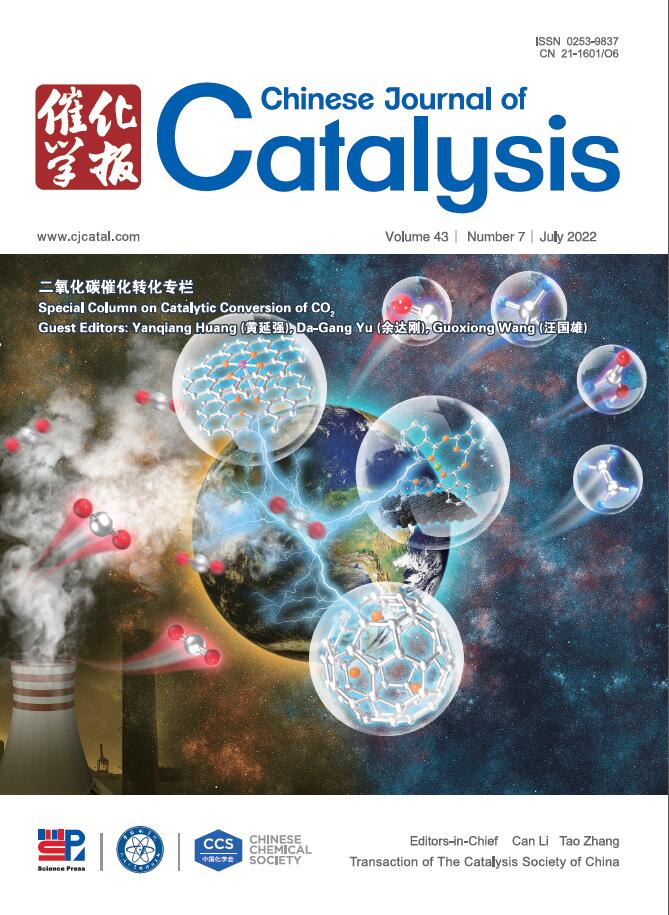Catalytic production of fused tetracyclic high-energy-density fuel with biomass-derived cyclopentanone and benzoquinone
IF 15.7
1区 化学
Q1 CHEMISTRY, APPLIED
引用次数: 0
Abstract
High-energy-density (HED) fuels (e.g. JP-10) are of great importance in safeguarding territorial air security, since they can increase the flight range and payload of military aircrafts. To reduce the reliance on limited petroleum source, the production of HED fuel with renewable biomass feedstocks is highly appealing. But currently, most of the synthetic biofuels, due to their intrinsic ring structure, are incapable of competing with JP-10 in terms of energy density and freezing point. By emulating the structural characteristic of JP-10, we herein design and prepare a special C16 fused tetracyclic biofuel using renewable cyclopentanone and benzoquinone as feedstocks. Key to success depends on selective dehydration of vicinal diol (dimer of cyclopentanone) over Amberlyst-15 in [Hmim]Cl. The Amberlyst-15/[Hmim]Cl system effectively suppresses the dominant pinacol-type rearrangement pathway and also exhibits good reusability for the dehydration. The hydrogen-bonding interaction between vicinal diol and imidazolium ring, as well as electrostatic force between carbocation intermediate and chloride anion contribute to the high diene selectivity. The compact ring framework gives rise to a density of 0.966 g/mL, combustion heat of 43.1 MJ/L, freezing point of ‒67 °C, and kinematic viscosity of 12.4 cSt, which are comparable to the properties of JP-10. It is expected that this as-prepared HED biofuel may potentially serve as a renewable alternative to petroleum fuel JP-10.
求助全文
约1分钟内获得全文
求助全文
来源期刊

Chinese Journal of Catalysis
工程技术-工程:化工
CiteScore
25.80
自引率
10.30%
发文量
235
审稿时长
1.2 months
期刊介绍:
The journal covers a broad scope, encompassing new trends in catalysis for applications in energy production, environmental protection, and the preparation of materials, petroleum chemicals, and fine chemicals. It explores the scientific foundation for preparing and activating catalysts of commercial interest, emphasizing representative models.The focus includes spectroscopic methods for structural characterization, especially in situ techniques, as well as new theoretical methods with practical impact in catalysis and catalytic reactions.The journal delves into the relationship between homogeneous and heterogeneous catalysis and includes theoretical studies on the structure and reactivity of catalysts.Additionally, contributions on photocatalysis, biocatalysis, surface science, and catalysis-related chemical kinetics are welcomed.
文献相关原料
公司名称
产品信息
乐研
[Emim]BF<sub>4</sub>
乐研
[Emim]Cl
乐研
[Bmim]Cl
乐研
[Hmim]Cl
乐研
[Emmim]Cl
乐研
[PyBu]OTs
乐研
[PyBu]OTf
乐研
[Emim]Cl
乐研
[Bmim]Cl
乐研
[Hmim]Cl
乐研
[Emmim]Cl
乐研
[PyBu]OTs
乐研
[PyBu]OTf
阿拉丁
Cyclopentanone
阿拉丁
tetrahydrofuran
阿拉丁
titanium tetrachloride
阿拉丁
zinc powder
阿拉丁
sodium bicarbonate
阿拉丁
choline chloride
阿拉丁
1,4-benzoquinone
阿拉丁
phosphotungstic acid (HPW)
阿拉丁
phosphomolybdic acid
阿拉丁
Cyclopentanone
阿拉丁
tetrahydrofuran
阿拉丁
titanium tetrachloride
阿拉丁
zinc powder
阿拉丁
sodium bicarbonate
阿拉丁
choline chloride
阿拉丁
1,4-benzoquinone
阿拉丁
phosphotungstic acid (HPW)
 求助内容:
求助内容: 应助结果提醒方式:
应助结果提醒方式:


